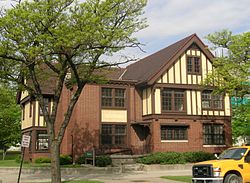University-Cultural Center Multiple Resource Area
|
University-Cultural Center MRA
|
|

Herman Strasburg House on Cass
|
|
| Location |
Detroit, Michigan |
|---|---|
| Coordinates | 42°21′35″N 83°4′9″W / 42.35972°N 83.06917°WCoordinates: 42°21′35″N 83°4′9″W / 42.35972°N 83.06917°W |
| Built | 1884-1927 |
| Architect | Marcus R. Burrowes; Cram, Wentworth & Goodhue; William G. Malcomson and William E. Higginbotham; Pollmar, Ropes & Lundy; James S. Rogers and Walter MacFarlane; William Scott & Co; F.W. Wiedmaier and John B. Gay; et al. |
| Architectural style | Gothic Revival, Queen Anne, Romanesque Revival, Second Empire, Other |
| MPS | University-Cultural Center MRA |
| NRHP Reference # | 86000996, 86001001, 86001003, 86001036 - 86001040, |
| Added to NRHP | April 29 and May 1, 1986 |
The University-Cultural Center MRA (Multiple Resource Area) is a pair of multiple property submissions to the National Register of Historic Places which were approved on April 29 and May 1, 1986. The structures included are all located in Midtown, near Woodward Avenue and Wayne State University in Detroit, Michigan. The two submissions are designated the University-Cultural Center MRA Phase I, containing five properties, and the University-Cultural Center MRA Phase II, containing three properties.
From the middle of the 19th century until the 1920s, the area that is now the University-Cultural Center was characterized by upper-class single-family homes. After the Civil War, the city of Detroit platted and sold lots along Woodward to private developers. Houses first appeared along Woodward in the 1860s, and construction in the area reached a peak in the 1880s and 1890s as developments off Woodward, first to the east and then to the west, were platted. Construction east of Second Avenue did not reach full swing until the early 1900s.
At the end of the 19th century, Central High School (now Old Main) was constructed on Cass and Warren. The building acted as a magnet, attracting other institutions that were educational and artistic in function, culminating in the erection of the Detroit Institute of Arts and the Detroit Public Library along Woodward Avenue in the 1920s.
The rise of the automobile in the 1910s and 1920s had a twofold effect on the University-Cultural Center area. The prosperous automotive trade increased the population of Detroit by nearly a factor of four between 1900 and 1920. This pushed the city limits far to the north, making what once had been a suburban, open area into the heart of the city. The University-Cultural Center area also became home to automotive-related commercial and industrial businesses, particularly along Woodward and Cass.
In the mid-1920s, large apartment buildings with first-floor commercial space were constructed in the area, bringing more residents into the area and reducing the pressure for store frontage. At the same time, the former residents of the upper-class, turn-of-the-century homes moved farther out into new neighborhoods such as Boston-Edison, Arden Park-East Boston, or Virginia Park. The remaining mansions were repurposed as boardinghouses or commercial space.
...
Wikipedia
